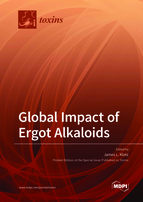Global Impact of Ergot Alkaloids
A special issue of Toxins (ISSN 2072-6651). This special issue belongs to the section "Mycotoxins".
Deadline for manuscript submissions: closed (15 June 2021) | Viewed by 45097
Special Issue Editor
Special Issue Information
Dear Colleagues,
For many years ergot alkaloids have been identified and studied as both problems or toxins to be mitagated and also as potential medical solutions or cures. These comounds have been primarily studied in the medical/pharmaceutical and agricultural fields. Depending on one’s perspective, the impact that ergot alkaloids have had on the progress of human medicine and livestock production can be either positive or negative. The dose or concentration of ergot alkaloid exposure is paramount. This can make the difference from these compounds being implicated in the morbidity and mortality of individuals with St. Anthony’s Fire to being used to treat migraines and post-partum bleeding or being used to maximize plant resistance and persistence and being framed as an animal welfare concern for grazing the livestock. The ethics of ergot alkaloid use is debated to this day, but there is no debating their impacts. Many of the positive and negative issues associated with ergot alkaloids have specific conditions with regional implications, but that does not diminsh the magnitude of impact that these compounds have had on humans, livestock, and plants globally. The focus of this special issue will include original research and review articles that highlight benefits and detriments and successes and failures involving ergot alkloids around the world with deference to regional distinctions. What role have ergot alkaloids played and continue to play in your country, your region, and on your research?
We all focus on how ergot alkaloids influence (positive or negative) our individual situation. There is a benefit to this shared interest even if the issues with ergot alkaloids don’t directly overlap.
Dr. James L. Klotz
Guest Editor
Manuscript Submission Information
Manuscripts should be submitted online at www.mdpi.com by registering and logging in to this website. Once you are registered, click here to go to the submission form. Manuscripts can be submitted until the deadline. All submissions that pass pre-check are peer-reviewed. Accepted papers will be published continuously in the journal (as soon as accepted) and will be listed together on the special issue website. Research articles, review articles as well as short communications are invited. For planned papers, a title and short abstract (about 100 words) can be sent to the Editorial Office for announcement on this website.
Submitted manuscripts should not have been published previously, nor be under consideration for publication elsewhere (except conference proceedings papers). All manuscripts are thoroughly refereed through a double-blind peer-review process. A guide for authors and other relevant information for submission of manuscripts is available on the Instructions for Authors page. Toxins is an international peer-reviewed open access monthly journal published by MDPI.
Please visit the Instructions for Authors page before submitting a manuscript. The Article Processing Charge (APC) for publication in this open access journal is 2700 CHF (Swiss Francs). Submitted papers should be well formatted and use good English. Authors may use MDPI's English editing service prior to publication or during author revisions.
Keywords
- Ergot alkaloids
- Toxin
- Drug development
- Medicine
- Livestock
- Endophyte







